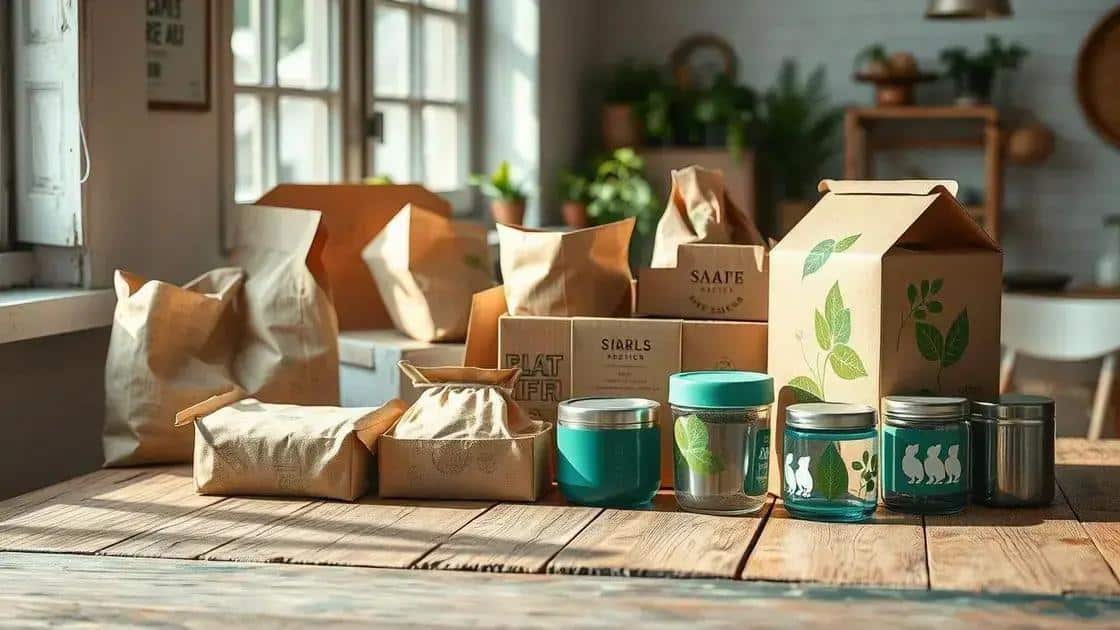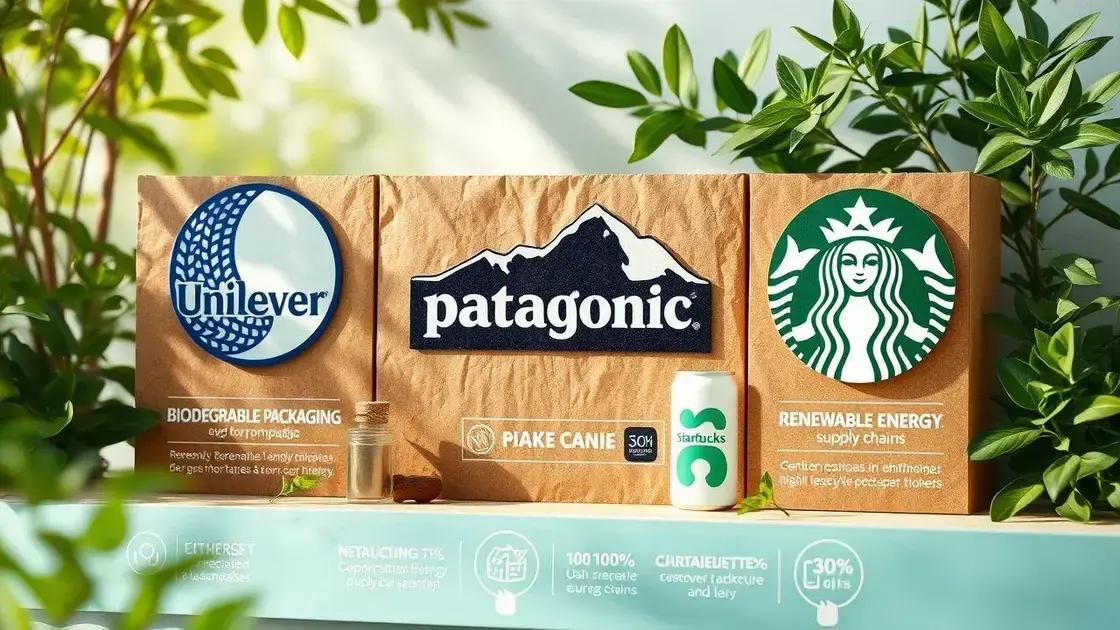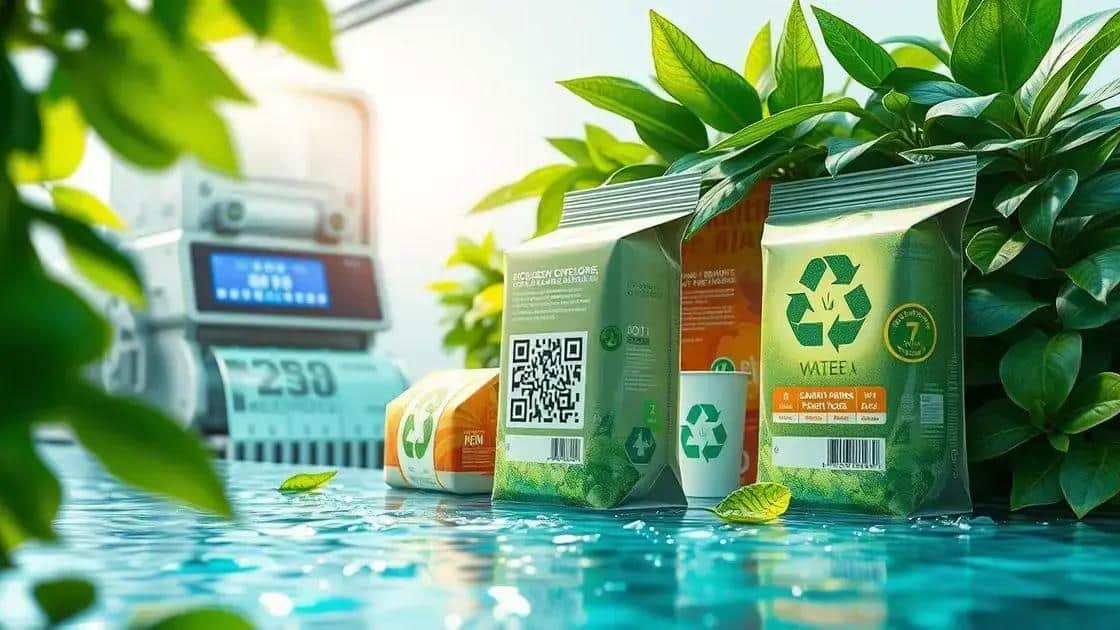Sustainable packaging news trends you need to know

Sustainable packaging news trends focus on innovations like biodegradable materials, smart packaging technologies, and advanced recycling methods that significantly reduce environmental impact and cater to growing consumer demand for eco-friendly solutions.
Sustainable packaging news trends are more important than ever as consumers demand greener options. From biodegradable materials to innovative designs, these trends reveal how industries are adapting to a more eco-conscious world.
Emerging sustainable packaging materials
In recent years, innovation in sustainable packaging materials has gained momentum. These materials are designed to reduce environmental impact while maintaining functionality.
Types of Emerging Materials
One example is bamboo packaging, which is biodegradable and renewable. Bamboo grows quickly and can be harvested sustainably, making it an excellent choice for eco-friendly packaging solutions.
- Bioplastics from corn or sugarcane
- Mushroom-based packaging
- Recycled paper and cardboard
Another exciting development is mushroom packaging, created from agricultural waste and mycelium. This material is compostable and offers a unique, natural look.
Benefits of Using Sustainable Materials
Utilizing sustainable materials can help companies lower their carbon footprint. Consumers are increasingly drawn to brands that prioritize environmental responsibility.
- Reduction in waste
- Lower energy consumption
- Enhanced brand loyalty
As the demand for sustainability grows, companies are rethinking their packaging strategies. By transitioning to sustainable materials, they can lead the way to a more environmentally friendly future.
Top companies leading the sustainability charge

Many companies are stepping up to embrace sustainability and are leading the charge in the industry. These top companies are implementing innovative practices to reduce their environmental impact.
Notable Leaders in Sustainable Practices
For instance, Unilever has committed to making its products more sustainable by focusing on reducing plastic waste. They have introduced refillable and compostable packaging options, showing a clear path toward a greener future.
- The use of renewable energy sources
- Investment in sustainable agriculture
- Transparency in supply chains
Another great example is Patagonia, known for its dedication to environmental causes. The company actively encourages customers to repair and reuse their gear, promoting a cycle of sustainability.
Innovation and Impact
Starbucks is also making significant strides by pledging to eliminate plastic straws and enchant its product packaging with recycled materials. This commitment has resonated well with environmentally conscious consumers, creating a positive brand image.
- Partnerships with sustainability-focused organizations
- Investing in renewable energy projects
- Creating awareness and educational programs
These companies show how leading the sustainability charge can not only benefit the planet but can also enhance their brand legacy and engage customers effectively. Such initiatives are increasingly important as consumers seek to support companies that align with their values.
Consumer preferences for eco-friendly packaging
Understanding consumer preferences for eco-friendly packaging is crucial in today’s market. More shoppers are seeking products that come in sustainable packaging. This shift reflects growing awareness about environmental issues and sustainability.
Key Factors Influencing Choices
One major factor is the demand for transparency. Consumers want to know where materials come from and how packaging is produced. Brands that are open about their sourcing tend to attract eco-conscious shoppers.
- Preference for biodegradable materials
- Interest in products with minimal packaging
- Support for companies that engage in sustainable practices
Another important aspect is the product’s overall impact on the environment. Many consumers are looking for packaging that is not only eco-friendly but also effective in protecting the product.
Shifts in Consumer Behavior
Recent studies show that younger generations are particularly motivated to choose eco-friendly options. They often prefer brands that prioritize sustainability over those that do not, indicating a significant shift in consumer expectations.
- Willingness to pay more for eco-friendly products
- Increased demand for recyclable packaging
- Initiatives that promote reuse and refill options
This growing preference for sustainable packaging has prompted businesses to adapt their strategies. By aligning with consumer values, brands can enhance their appeal while contributing to a healthier planet.
Future innovations in sustainable packaging

The future of sustainable packaging is bright, with many exciting innovations on the horizon. As companies strive to reduce their environmental impact, new technologies and materials are being developed to replace traditional packaging.
Biodegradable and Compostable Materials
One promising area is the growth of biodegradable and compostable materials. These materials break down naturally and do not contribute to landfill waste. For example, packaging made from plants, such as cornstarch or seaweed, is gaining popularity.
- Plant-based plastics
- Edible packaging
- Compostable films and bags
Another exciting innovation is the use of smart packaging. This technology provides information about the product’s freshness and can reduce food waste. Smart labels and QR codes help consumers track product details and expiration dates.
Advanced Recycling Technologies
Advancements in recycling technologies are also shaping the future of sustainable packaging. New processes can recycle materials that were once considered non-recyclable, making it easier to create a circular economy.
- Chemical recycling methods
- Improved sorting and separation technologies
- Closed-loop recycling systems
As research continues, we can expect more innovations that blend functionality with sustainability. Businesses that embrace these innovations not only reduce their environmental footprint but also meet the growing consumer demand for eco-friendly solutions.
In conclusion, the journey towards sustainable packaging is an exciting one. With innovations like biodegradable materials, smart technologies, and advanced recycling processes, we are on the brink of a significant change. Companies leading the charge are adapting to consumer preferences, while consumers are increasingly aware of their choices. By prioritizing sustainability, businesses can not only reduce their environmental impact but also engage customers who care about the planet. Together, we can build a future where sustainable packaging becomes the norm, ensuring a healthier Earth for generations to come.
FAQ – Frequently Asked Questions about Sustainable Packaging
What are some examples of sustainable packaging materials?
Examples include biodegradable plastics, compostable materials made from plants, and recycled paper products that reduce waste.
How does smart packaging work?
Smart packaging uses technology such as QR codes and sensors to provide consumers with information about freshness and product details, helping reduce waste.
Why is consumer awareness about sustainable packaging important?
Consumer awareness drives demand for eco-friendly options, encouraging companies to adopt sustainable practices and innovate in their packaging strategies.
What role do companies play in promoting sustainable packaging?
Companies can lead the charge by investing in innovative materials, improving recycling processes, and adopting eco-friendly practices, aligning with consumer values.





